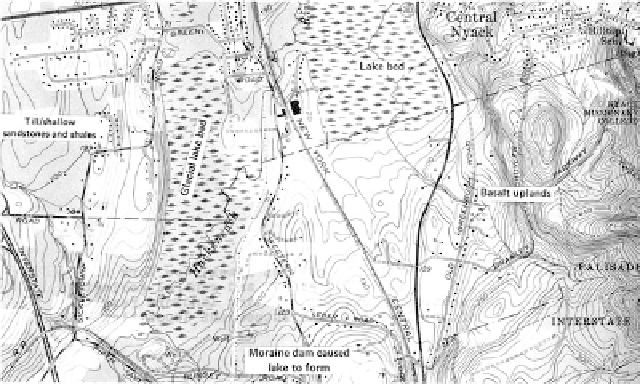Environmental Engineering Reference
In-Depth Information
dewatering with vacuum well points set into the silt stratum to decrease pore pressures and
increase apparent cohesion. This procedure is often followed when preparing foundations
for buried pipe in trench excavations. There have been many cases of sewer pipe failures
when they were supported on improperly prepared foundations bearing in the silt.
7.6.4
Glacial-Lacustrine Soils
Origin
During the last period of glaciation, numerous lakes originated when end moraines
formed natural dams across glacial valleys. The lakes were subsequently filled with lacus-
trine soils from the outwash.
Mode of Occurrence
Overflowing from the larger lakes formed outlets that permitted them to drain.
Subsequent regional uplift as the glacier receded exposed many of the lake bottoms, and
during dry spells the upper portion of the lake bed soils became strengthened by desicca-
tion. These lakes remain in several forms as follows:
•
Lacustrine plains
cover vast areas such as Lake Agassiz in North Dakota,
Minnesota, and adjacent Canada.
•
Margins of existing lakes
such as underlie Chicago, Cleveland, and Toledo.
•
Terrace deposits
high above the present river valleys such as exist along the Hudson
River, at Albany, New York, and other rivers of the northeast (see
Figure 2.16
and
Figure 2.17),
and in the Seattle, Washington, area.
•
Saltwater tidal marshes
such as Glacial Lake Hackensack, New Jersey (see
Figure 2.5).
•
Freshwater swamps
such as Glacial Lake Passaic, New Jersey (see
Figure 6.19),
and
many other lakes in the northeastern United States. The topographic expression
and a geologic section through a glacial lake bed in West Nyack, New York, is
given in Figure 7.88 and
Figure 7.89,
respectively.
FIGURE 7.88
Topographic expression of a freshwater swamp over a glacial lakebed, and adjacent glaciated high ground
(West Nyack, New York). (Courtesy of USGS.)



